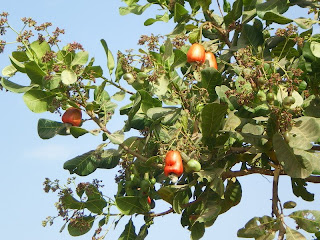For good, bad or otherwise, the belief in magic is a big part of the daily life of most Gambians. People wear amulets, called “jujus” or “safoo” to ward off spirits and sickness, or to bring about good things. These jujus are verses of the Koran written out, then stitched in leather pouches that are then worn on the body, often around the waist, neck, wrist, or upper arm. Babies wear big long strings of them. Other jujus are made for other purposes. For example goats keep coming into the compound and they eat our cassava, so my host father made up a juju by boiling something in a rams horn, then tying it with a red string and hanging it in the cassava. He said that if the thief came back, he would be frozen in his tracks by the juju, and we would find him there(this surprised me, because my host father is educated, but that just goes to show how pervasive this practice is in the country. Education or not, he still relies on magic.). Many people have jujus hanging in the doorway to keep spirits out.
These jujus are made by “marabouts”, traditional medicine men. These men are trained in Koranic studies, but many of their practices are from before Islam came to the area. Marabouts are also able to cast spells for people to influence events, etc.
There is also many beliefs about devils. My host mother won’t let me go out of the compound after 7 PM, because of devils. I thought this was s euphemism, and maybe the neighborhood isn’t safe. She insisted its not the neighborhood, but if a devil saw me, I would get an incurable sickness and die.
I was out in the bush taking pictures, and had stopped to photograph a giant termite mound, when a little girl came out of nowhere to tell me to get away from it, its not safe. I asked why, she didn’t say, but just said that it was not safe. Later, I asked my host brother, and he said that a devil, disguised as a serpent, lives there and if it sees me, and I see it, I’ll die.
I think that the traditional beliefs are interesting, and I don’t advocate loss of culture, but where they get in the way, is when I’m trying to advocate more concrete behavior change to protect people’s health or promote development, and many times people are happy to just rely on the possibility of magic. One of my PCV friends coaches a soccer team, but its difficult to get his team to practice, because apparently soccer, in his village, is more a battle of the marabouts, and the medicine men cast spells throughout the game. You only win if you marabout is stronger. Yes, I’m fine with your baby wears jujus, but lets get him inoculated too, ok? Sure, wear jujus, but also study for your school test rather than hoping your marabout cast a strong spell. I actually think that jujus are kind of cool looking, and I would wear one with my binbins, but then I feel like that would be an endorsement, and work against my urging people to take more effective actions. The presence of magic sort of just removes the aspect of personal responsibility in a situation, and that’s hard for me to overcome.
Although, as far as going out after dusk….devils or no devils, its probably safest to stay in anyway.








.JPG)



